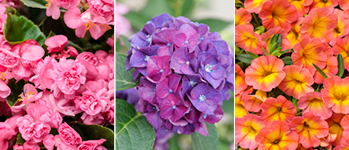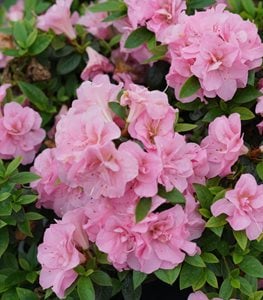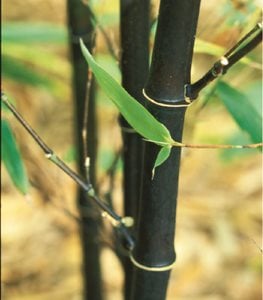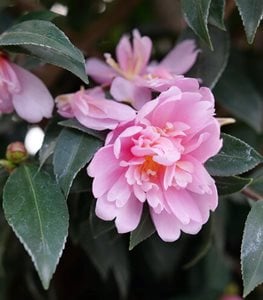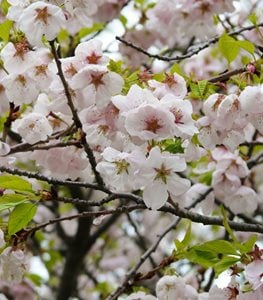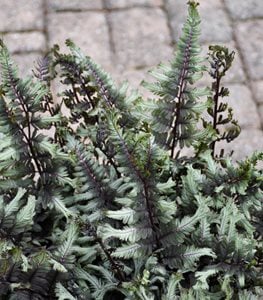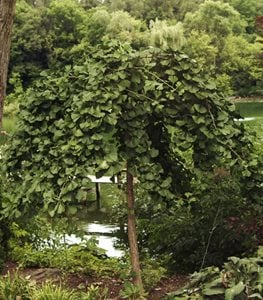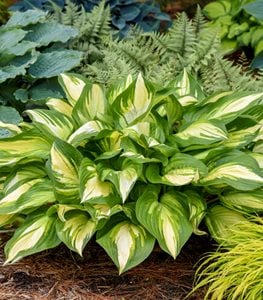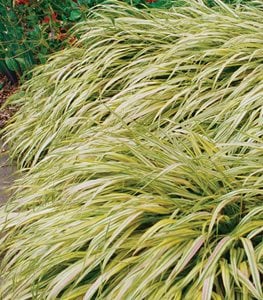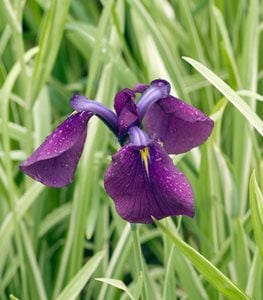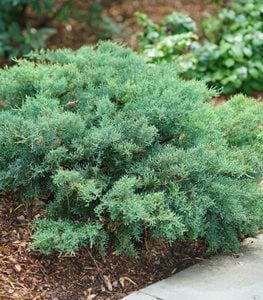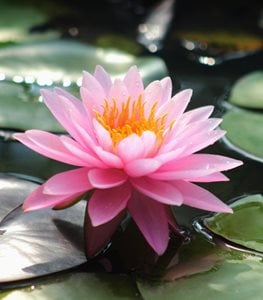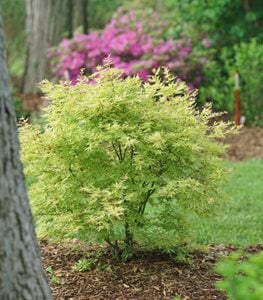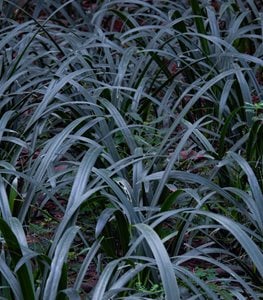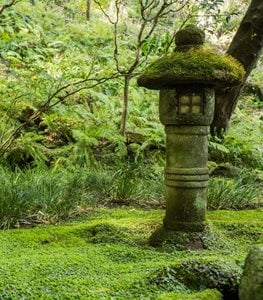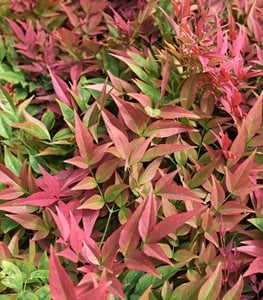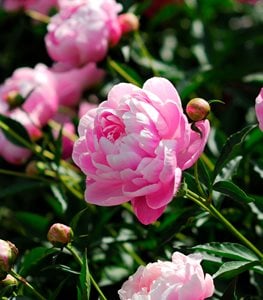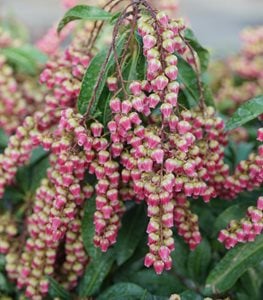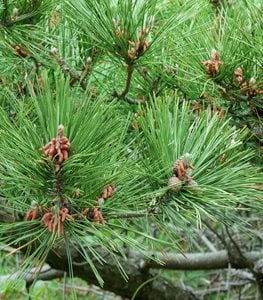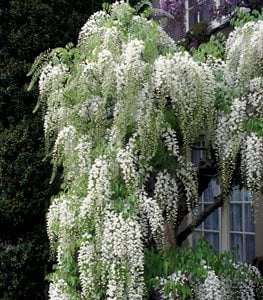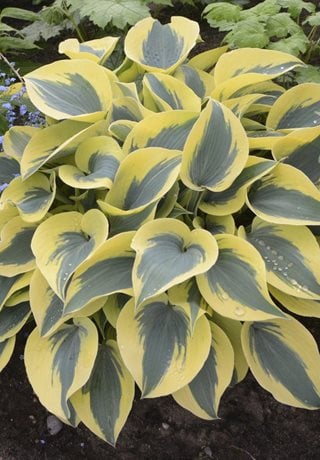20 Japanese Garden Plants to Grow
Get inspired by these beautiful plants for Japanese-style landscapesGardens have been an essential part of Japanese culture for hundreds of years, dating back to when they were central features of ancient religious temples and royal palaces. These gardens were intended as places to connect with nature and inspire calming, peaceful meditation. Today, Japanese gardens can be found throughout Japan, from public spaces to residential yards. Gardeners worldwide have incorporated this garden planting style into their own landscapes.
There are many types of trees, shrubs, perennials, and ground covers that are traditionally used as Japanese landscaping plants—from lush, ground-hugging mosses to towering ginkgo trees. Many traditional Japanese plants are native to Japan and other parts of Asia, holding deep religious and spiritual meaning. To create an authentic Japanese aesthetic, include some of these plants for Japanese gardens in your yard.
AZALEA (Rhododendron spp.)
Plant type: Deciduous or evergreen shrub
Zones: 3-9, depending on the variety
Exposure: Full sun to partial shade
Habit: Upright, bushy, spreading or groundcover habit
Height/Spread: 1 to 20 feet tall, 2 to 20 feet wide
Bloom time: Early spring to summer; some varieties rebloom
Azaleas are widely grown throughout Japan, and are celebrated during spring festivals when they are in full colorful bloom. These evergreen or deciduous shrubs produce bell-shaped flowers in a range of vivid colors, thriving in woodland settings with partial or dappled shade. Azaleas have significant cultural meaning, symbolizing beauty, renewal, the transience of life, and the changing seasons. Read more about how to grow azaleas.
Pictured: Perfecto Mundo® Double Pink reblooming azalea from Proven Winners.
BAMBOO (Phyllostachys spp.)
Plant type: Evergreen grass
Zones: 5-11
Exposure: Full sun to partial shade
Habit: Upright spreading habit
Height/Spread: 15 to 70 feet tall, 8 to 25 feet wide
Bamboos are evergreen grasses that can be found growing throughout Japan, from tall, dense forests to refined plantings in tea gardens and at residential homes. The slender segmented stalks of bamboo occur in shades of brown, green, black, yellow, red, and blue. The stalks are widely used for roofing, fencing and products such as chopsticks, with the shoots a staple of Japanese cuisine. Bamboo is at once flexible and strong, representing the ability to rise above adversity. It also symbolizes growth, prosperity, purity and simplicity. Running bamboo should be contained in pots or with barriers to prevent unwanted spread. Read more about the different types of bamboo plants.
CAMELLIA (Camellia spp.)
Plant type: Evergreen shrub
Zones: 7-10
Exposure: Partial shade
Habit: Upright bushy habit
Height/Spread: 2 to 20 feet tall, 2 to 10 feet wide; depending on the variety
Bloom time: Late fall to mid-spring, depending on the variety
This evergreen shrub, native to Japan and China, produces thick glossy green leaves and large delicate flowers. Camellia prefer moist conditions and a semi-shaded woodland setting. Named tsubaki in Japan, camellias frequently appear in Japanese art and literature, signifying the fleeting nature of life, beauty, inner strength, and perseverance. Read more about how to grow camellias.
Pictured: Just Chill® Double Pink camellia from Proven Winners.
CHERRY TREE (Prunus spp.)
Plant type: Deciduous tree
Zones: 4-9
Exposure: Full sun to partial shade
Habit: Upright habit with a spreading canopy
Height/Spread: 6 to 30 feet tall, 4 to 30 feet wide
Bloom time: Spring
Cherry trees hold deep symbolic meaning in Japanese culture. These deciduous trees produce an abundance of delicate pink or white blossoms in spring. Named sakura, the blossoms and short bloom time represent renewal, hope, and the fleeting nature of life. Cherry trees are depicted in Japanese art, poetry, and festivals, with hanami (cherry blossom viewing) a traditional practice of mindfulness and gratitude. Popular garden varieties include ‘Akebono’ (pictured), ‘Kwanzan’ and ‘Shirotae’. Read more about how to grow flowering cherry trees.
FERNS (Various spp.)
Plant type: Herbaceous perennial
Zones: 3-11
Exposure: Partial sun to shade
Habit: Upright, compact, or vase-shaped habit
Height/Spread: Varies by genus and species
Bloom time: No flowers
Ferns are a staple of Japanese gardens, creating a lush, serene look in shady areas. There are many different species of ferns, which are characterized by an elegant growth habit and green, silver, or purple fronds. Some of the most commonly used ferns in Japanese gardens include Japanese painted fern (Athyrium niponicum var. pictum), maidenhair fern (Adiantum spp.), ostrich fern (Matteuccia struthiopteris) and Japanese deer fern (Blechnum nipponicum). In Japanese culture, ferns signify adaptability, resilience, growth, and transformation. Read more about popular ferns.
Pictured: 'Crested Surf' Japanese painted fern from Proven Winners.
GINKGO TREE (Ginkgo biloba)
Plant type: Deciduous tree
Zones: 3-9
Exposure: Full sun to partial shade
Habit: Upright, spreading, rounded, columnar, or dwarf habit
Height/Spread: 50 to 80 feet tall or more, 30 to 40 feet wide; dwarf varieties are smaller
Bloom time: Spring
Described as living fossils, ginkgo trees are revered in Japanese culture, enjoying a prominent place in ancient Japanese temple gardens for hundreds of years. With a stately stature and unique fan-shaped leaves that turn brilliant shades of gold and yellow in fall, these long-lived trees are celebrated in Japanese festivals. Smaller varieties such as ‘Jade Butterflies’, ‘Pendula’ (pictured), and ‘Mariken’ are suited to home gardens. In Japanese culture, ginkgo trees symbolize longevity, resilience, hope and peace. Read more about how to grow ginkgo trees.
HINOKI CYPRESS (Chamaecyparis obtusa)
Plant type: Evergreen conifer
Zones: 4-8
Exposure: Full sun to partial shade
Habit: Upright pyramidal habit
Height/Spread: 50 to 70 feet tall, 10 to 25 feet wide; dwarf varieties are smaller
Bloom time: No flowers
Native to Japan, Chamaecyparis obtusa is an evergreen conifer with an elegant upright habit, horizontal branching, and flat fan-shaped sprays. The durable aromatic wood of Hinoki cypress is considered sacred in Japanese culture, used to build shrines, temples, and tubs for bathing. This revered tree is believed to possess spiritual powers, symbolizing purity and longevity. Smaller varieties suitable for home gardens include ‘Nana Gracilis’ (pictured), ‘Pygmaea’ and ‘Nana Aurea’. Hinoki cypress can be used as screening, a focal point, or grown as a bonsai specimen. Read more about how to grow false cypress trees.
HOSTA (Hosta spp.)
Plant type: Perennial
Zones: 3-9
Exposure: Partial sun to shade
Habit: Mounding spreading habit
Height/Spread: 2 to 48 inches tall, 5 to 60 inches wide
Bloom time: Summer
One of the most popular shade-loving perennials, Hosta is grown for the attractive foliage that comes in wide range of sizes, colors, and patterns. This long-lived plant is commonly found throughout Japan, instilling a calm lushness and refined elegance that Japanese gardens are known for. Known as giboshi In Japanese culture, hosta signifies tranquility, harmony with nature, resilience, and adaptability. Read more about how to grow hosta plants.
Pictured: Shadowland® 'Miss America' hosta from Proven Winners.
JAPANESE FOREST GRASS (Hakonechloa macra)
Plant type: Perennial grass
Zones: 5-9
Exposure: Partial sun to shade
Habit: Mounding arching habit
Height/Spread: 12 to 18 inches tall, 12 to 24 inches wide
Bloom time: Summer; flowers are insignificant
Also known as Hakone grass, this popular perennial is native to Japan, where it is found growing as an understory plant in forested mountain regions. One of the few ornamental grasses that thrives in shade, Hakonechloa has green, gold, or variegated foliage and a cascading habit, adding elegance and serenity to traditional Japanese-style landscapes. Use as a ground cover, in containers or mass plantings. Read more about how to grow Japanese forest grass.
Pictured: Aureola Japanese forest grass from Proven Winners.
JAPANESE IRIS (Iris ensata)
Plant type: Perennial
Zones: 4-9
Exposure: Full sun to partial shade
Habit: Upright spreading habit
Height/Spread: 2 to 4 feet tall, 1 to 2 feet wide
Bloom time: Late spring to early summer
This stunning flowering perennial has been cultivated in Japan for centuries. Large vividly colored flowers with weeping petals are borne on tall slender stems, lending elegance to ponds, bog gardens, and other water features. Referred to as hanashobu, Japanese iris holds deep cultural meaning and is commonly depicted in Japanese art and literature. This revered flower symbolizes beauty, hope, elegance, and purity. Read more about growing iris plants.
JUNIPER (Juniperus spp.)
Plant type: Evergreen conifer
Zones: 2-10, depending on the variety
Exposure: Full sun to partial sun
Habit: Upright, spreading, or weeping habit
Height/Spread: 6 inches to 130 feet tall, 1 to 25 feet wide
Bloom time: No flowers
Junipers are evergreen conifers commonly used in Japanese landscapes for year-round color and structure. With an upright, weeping, or ground cover habit, they are often used in Japanese rock gardens or pruned into bonsai specimens. In Japanese culture, juniper represents endurance, longevity, and resilience. Smaller varieties suited to home landscapes include Montana Moss® (pictured), Gin Fizz®, ‘Blue Star’, and ‘Blue Rug’ creeping juniper. Read more on growing junipers.
Pictured: Montana Moss® juniper from Proven Winners.
LOTUS (Nelumbo nucifera)
Plant type: Aquatic perennial
Zones: 4-10
Exposure: Full sun
Habit: Upright spreading habit
Height/Spread: 3 to 6 feet tall, 3 to 4 feet wide
Bloom time: Summer
One of the most sacred flowers in Asian cultures, lotus has long been a symbol of rebirth, enlightenment, and purity. This aquatic plant is grown in ponds or bogs, producing large rounded leaves that float above the water. The exquisite flowers with a delicate fragrance are borne on tall slender stems, with exotic seed pods that become prominent as the petals drop off.
JAPANESE MAPLE (Acer palmatum)
Plant type: Deciduous tree
Zones: 5-8
Exposure: Partial sun to partial shade
Habit: Upright, spreading, or weeping habit
Height/Spread: 8 to 30 feet tall and wide
Bloom time: Spring; flowers are inconspicuous
Native to Japan, China, and Korea, Acer palmatum is a small to medium-sized deciduous tree that is prized for its graceful structure, palmate leaves, and brilliant fall color. Widely used in Japanese-style landscapes, these elegant trees have a serene presence, and are often featured in Japanese art, celebrated in festivals and ceremonies. Japanese maples have deep symbolic meaning, representing seasonal change, emotional depth, and the fleeting beauty of nature. Read more on growing Japanese maple trees.
Pictured: Metamorphosa® Japanese maple from Proven Winners.
MONDO GRASS (Ophiopogon spp.)
Plant type: Perennial
Zones: 6-11
Exposure: Full sun to shade
Habit: Low spreading habit
Height/Spread: 1 to 12 inches tall, 4 to 24 inches wide, depending on the variety
Bloom time: Summer
Native to Japan, Korea, and China, Ophiopogon is a slow-growing, evergreen perennial forming dense clumps of grass-like foliage in colors of green, black, or variegation. The minimalist appearance is compatible with Japanese design style, used in rock gardens, mass plantings or as edging along pathways and beds. In Japan, mondo grass symbolizes adaptability and resilience for its ability to thrive in sun or shade.
MOSS (Various spp.)
Zones: Varies according to genus and species Exposure: Partial shade to full sunHabit: Groundcover habit
Height/Spread: Typically from 0.1 inch to 4 inches tall and variable spread, depending on the type.
Bloom time: No flowers
Moss is a predominant feature in Japanese landscapes, adding a verdant green aesthetic to slopes, trees, rocks, statuary, and lanterns. Known as koke, these lush ground covers thrive in shade and moist soils where little else will grow, covering large areas and making a good substitute for traditional lawns. Mosses are common zen garden plants where a minimalist look is desired. In Japanese culture, moss represents the passage of time and wabi sabi, the aesthetic of simplicity and imperfection. Varieties commonly used in Japanese landscapes include juniper haircap moss (Polytrichum juniperinum), gray fringe moss (Racomitrium canescens) and hairy cap moss (Polytrichum formosum).
HEAVENLY BAMBOO (Nandina domestica)
Plant type: Evergreen or semi-evergreen shrub
Zones: 6-9
Exposure: Full sun to partial shade
Habit: Upright bushy habit
Height/Spread: 4 to 8 feet tall, 2 to 4 feet wide
Bloom time: Spring
Also known as sacred bamboo, this evergreen or semi-evergreen shrub is native to Japan and east Asia, and is widely used in Japanese garden design. Not a true bamboo, nandina has cane-like stems, bamboo-like foliage, and bright red berries that add winter interest to the landscape. In Japanese culture, heavenly bamboo is thought to protect the home from harm, and signifies good fortune. May be invasive in some regions.
PEONY (Paeonia spp.)
Plant type: Perennial Zones: 2-8
Plant type: Perennial
Exposure: Full sun to light shade
Habit: Upright or bushy habit
Height/Spread: 1 to 7 feet tall, 1 to 5 feet wide
Bloom time: Mid to late spring
Peony is a deeply cherished flower in Japanese culture, celebrated in art, literature, traditional ceremonies, and festivals. Grown for the showy fragrant blooms that appear in mid to late spring, this long-lived perennial thrives in full sun with rich, well-drained soil and regular moisture. In Japanese culture, peonies signify prosperity, luck, and honor. Read more on growing peonies.
JAPANESE PIERIS (Pieris spp.)
Plant type: Evergreen shrub
Zones: 5-8
Exposure: Full sun to partial shade
Habit: Upright bushy habit
Height/Spread: 3 to 12 feet tall, 3 to 8 feet wide, depending on the variety
Bloom time: Late winter to early spring
Also known as Japanese andromeda or lily-of-the-valley shrub, this broadleaf evergreen produces glossy foliage, colorful new growth and long dangling clusters of bell-shaped flowers in spring. Native to mountainous regions of Japan, this woodland shrub adds serene elegance to Japanese-style borders and foundation plantings. Known as asebi in Japan, pieris was historically planted in tea gardens, shrines and temples, representing endurance and resilience. Read more on growing pieris shrubs.
Pictured: Interstella® Lily of the Valley shrub from Proven Winners.
JAPANESE BLACK PINE (Pinus thunbergii)
Plant type: Shrub
Zones: 5-8
Exposure: Full sun
Habit: Upright habit
Height/Spread: 20 to 60 feet tall, 12 to 20 feet wide; dwarf varieties stay smaller
Bloom time: No flowers
Native to coastal regions of Japan and South Korea, Japanese black pine is widely used in Japanese landscapes as an understory tree, and is one of the most popular bonsai specimens. This evergreen conifer has an irregular twisting growth habit, long green needles, and showy new growth, known as candles. Pines symbolize resilience and longevity in Japanese culture.
WISTERIA (Wisteria floribunda)
Plant type: Woody vine
Zones: 4-9
Exposure: Full sun to partial shade
Habit: Vining habit
Height/Spread: 10 to 30 feet long, 10 to 20 feet wide
Bloom time: Spring to summer
Wisteria is the epitome of elegance in Japanese gardens, with a vining habit and long dangling clusters of pea-like flowers in spring. Known as fuji, wisteria has long been featured in Japanese public parks, gardens, and ancient temples, and depicted in traditional Japanese artwork. This vigorous perennial vine is meticulously pruned and trained over arbors and gates, or as tunnels. In Japanese culture, wisteria represents love, kindness, longevity, and the fleeting nature of life. Wisteria may be invasive in some regions. Read more on growing wisteria.
ABOUT THE AUTHOR
Janet Loughrey is a veteran garden writer and photographer with over 25 years of experience, contributing to major publications like Garden Design, Better Homes and Gardens, and Sunset. A former Master Gardener, she brings hands-on expertise from gardening in a wide range of climates, from upstate New York to the Pacific Northwest.
RELATED:
Japanese Garden Design
Zen Garden Design

